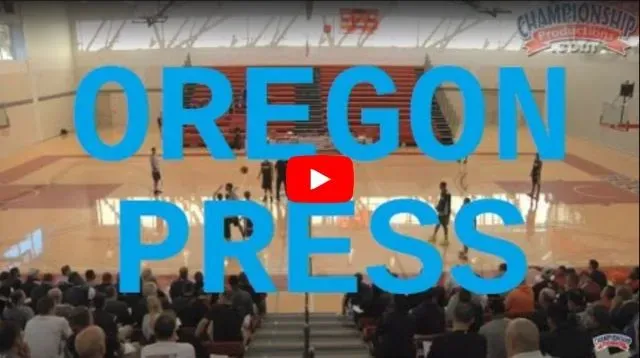Basketball Defense - 1-2-2 Full-Court Zone Press
From the Coach’s Clipboard Basketball Playbook"Helping coaches coach better..."
Disclosure: This page contains affiliate links, which means that Coach's Clipboard receives a small commission (at no cost to you) if you make a purchase using these links.


Coach Sartini
This 1-2-2 zone press is an easy press to teach, and is a fairly safe press to run with some "back" coverage to prevent the lay-up. There are several variations of this press. With each of these variations, X1, X2 and X3 work together as a unit, while X4 and X5 work together as your "back" unit. As with most other presses, always try to keep the ball out of the middle of the floor.
"80" is an aggressive 3/4 court press with trapping in the back-court.
"70" is a "safe" press with just mild pressure designed to control the tempo and burn some clock.
"76" looks like "70" with mild pressure, but then an aggressive trap is made once the ball is across the half-court line, in the corners.
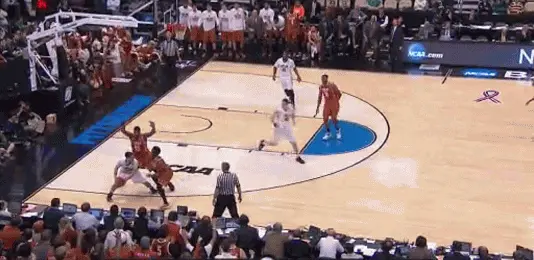
"80"
This is the aggressive 3/4 court trapping press. We always want to keep the ball out of the middle and force toward the sidelines. Refer to the diagrams below.See Diagram A. X1 has responsibility for pressuring the ball and stopping penetration back to the middle. He/she can either attack and trap immediately, or wait until the ball-handler starts the dribble and then attack. If you want extreme pressure (like late in the game), go straight man-to-man.
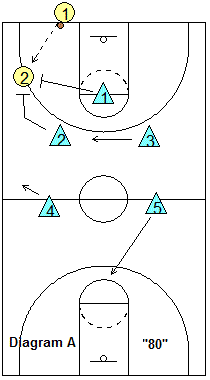
X2 and X3 have sideline and middle responsibility, preventing dribble-penetration up the sideline and closing the trap with X1. If the ball is along the right sideline, X2 and X1 trap while X3 prevents the pass into the middle. X4 slides up to the ball-side half-court line to prevent the pass up the sideline. X5 drops back as the safety in the middle, deep to prevent the long diagonal pass. A teaching point... teach X4 and X5 to keep their butts toward the middle of the floor to get to the sideline for steals and deflections.
Ball ReversalSee Diagram B. If the ball is passed back to the inbounder, X1 slides over a little but still wants to deny the pass back to O2. X3 waits in the middle until X2 rotates over to the middle and then X3 slides to the right. X3 should not leave the middle until X2 is there as this could allow the ball to get up the middle. Notice that your "back unit" has rotated with X4 and X5 assuming a position similar to what they started with in Diagram A.
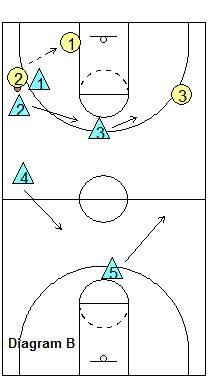
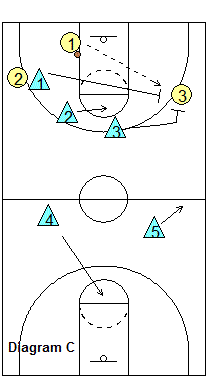
See Diagram C. As the ball is reversed to the opposite sideline, X3 now prevents the sideline dribble penetration, X1 sprints over to trap and X2 denies the middle pass. X5 now rotates up to the ball-side sideline at half-court to prevent the pass up the sideline. X4 now drops back as the deep, middle "safety".
Each time the ball is reversed, the defenders must give up some ground and move backward some so that X1 will have a better angle to trap.
With "80", Coach Sar says they could usually get one good, hard trap deep and sometimes a second trap either just before or after half-court. But usually it was 'one and done" and everyone retreats looking for the half court trap. They ALWAYS looked for this trap no matter what the call was.
"70"
This is a "safe" press with just mild pressure applied and no trapping. It is "safe" because there is no real gambling, you don't give up the lay-up, and there is less chance of committing a foul. The objective is to control the tempo, slow down the offense a little and burn some clock. The defenders set up a little deeper than in "80" (see Diagram D), and just "float" in front of the offense, slowing their progression up the floor, while keeping the ball in front of them (no long passes). If you have a very quick, aggressive point guard, allow him/her to pressure the ball all over the court.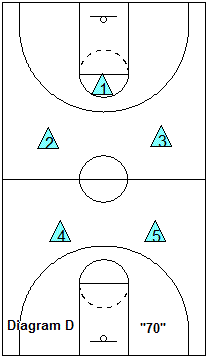
X1 sets up just inside the top of the key and X2 and X3 set up a little farther outside the arc. X4 and X5 drop back a little as well.
Anytime you utilize this press, you can still look for the half court trap as in "76" below. When a team thinks that you are just controlling tempo, the trap seems to work well.
"76"
This variation starts out like "70" with just mild pressure. We try to lull them to sleep, while gently steering them and inviting them to cross half-court along the sideline (see the red blocks in Diagram E).Once the ball crosses half-court, we aggressively trap in that corner, red block area. You could set the trap with X1 and either X2 or X3 (depending on which side of the floor) and use rules similar to "80" wherein the opposite wing (X2 or X3) denies the middle pass. X2 and X3 have to "act" a little and seem dis-interested in trapping to get the ball to enter the half-court along the sideline.
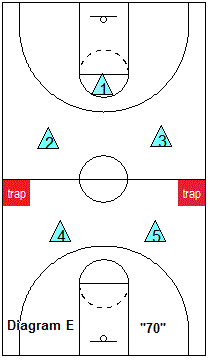
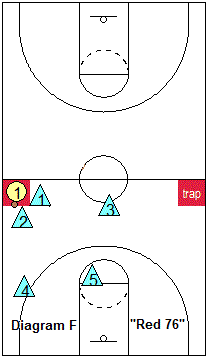
A variation is "Red 76". X1 and X2 (or X3 depending on which side of the floor the ball is on) will trap in the red corner (Diagram F). The opposite wing (X3 or X2) will deny the reversal pass back to the middle. We have the ball-side deep player X4 move to the sideline to deny the pass up the sideline, while X5 denies the pass to the middle.
Obviously bringing X5 up from the safety position is a gamble, opening the door for a long, diagonal pass under the basket. You probably only want to use this option once in awhile as a surprise tactic. If you do this all the time, you will eventually get beaten by the long pass over the top.
Again, always try to keep the ball out of the middle of the floor. Communication between the defenders is vital. This is especially true between X2 and X3, and between X4 and X5. The one in the middle must not leave too soon on ball-reversal until the other has rotated over to deny the middle, as we always want to keep the ball out of the middle.
Coach Sar thinks his teams became more accomplished with "76" since there was less area to cover. And sometimes the offense would throw the ball away even with just the light "70" pressure, perhaps because they were confused and didn't know what the defense was going to do.
There were other times they ran either "70" or "76" just to get the ball out of the hands of the opponent's best player, and then, when that happened, they would go into a pressure man-to-man defense and deny the ball back to the best player.

